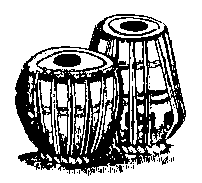
A publication of the Batish Institute of Indian Music and Fine Arts


Contents:
|
Keeping Good Rhythmby Ashwin Batish
Introduction:There is no big secret to learning to keep good time. It's a matter of understanding, diligent practice and perseverence. I will break down some of the basics of rhythm. From there, I will try and get you into a routine so that you can practice this at home. All you have to do is spend some time in trying to understand and then practice what I will show you. Very soon you'll be counting time like an expert! The Simple ApproachThis approach has to do with your daily routine. You can relate to good rhythm as a series of connecting events that flow together in harmony. This can be true in any area of your life but in a physical sense we perceive good rhythm by observing objects around us. For instance listen to your heart, your steps as you walk or run, to the rhythmic clatter of the railway trains. Examples of good rhythm are all around you.Counting time in music is simply a way to have your mind comfortable with listening and understanding the time value on which the music is based. We broadly call this rhythm. In Indian music, we call this tala. All talas move at a certain speed called tempo. In Indian music we call this laya. The more elaborate approachIn music, tala and laya take on a more rigid meaning. The tala side becomes more of a definite count of beats that repeat and have groups of 2, 3, 4, and 5 beats that when combined give rise to larger cycles. For instance, 2+3+2+3 = 10 beat cycle and 3+2+2= 7 beat cycle and so on.The laya (tempo) has three basic divisions vilambit (slow) madhya (medium) and drut (fast), although the actual divisions can be numerous. The other variations are simply called Ati Vilambit (very slow) or ati ati vilambit (very very slow) etc. Here is a rough breakdown of the tempo names:
We divide tala (rhythm cycles) into units of time called "matras" or beats. For instance Jhaptal is a rhythm cycle of 10 matras. As explained above, these are internally divided into subgroups of 2+3+2+3=10. As another example, In Ektal, a rhythm cycle of 12 beats, the internal division of beats is 2+2+2+2+2+2=12. These internal divisions are critical in forming the image of a tala and are called the tala's vibhag (measures). You now have the basic of understanding all the talas. Here now is an example of Rupak tal of 7 beats. Notice it has three vibhags divided 3+2+2=7 matras and when played on the tabla it is written and vocalized as Ti Ti Na | Dhi Na | Dhi Na. Now, visit my tabla lesson 8 to get an idea of some of the popular rhythm cycles called "Thekas." |
Please Note: All content is copyright ©2003 Ashwin
Batish. All rights reserved. Unauthorized copying, photocopying,
transmitting this document on hard paper or electronically or by any other
means is strictly prohibited and unlawful. You have our permission to link
to this page.
|